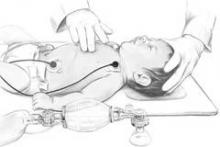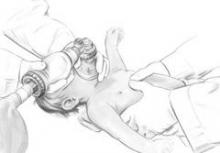SAN FRANCISCO – Children in cardiopulmonary arrest require specialized resuscitation skills, and updated guidelines published late in 2010 contain some new recommendations, according to Dr. Marianne Gausche-Hill.
The recommended sequence for cardiopulmonary resuscitation (CPR) "has changed for all ages except for the newborn" to compressions, airway, breathing (CAB) – instead of airway, breathing, compressions (ABC) – when performed by a bystander. Emergency department (ED) providers usually will ventilate and do compressions simultaneously.
"If you’re doing bag mask [ventilation], the recommendation is just do your ventilations, and do compressions separately. If the patient has been intubated, you can do continued ventilations as you’re doing compressions," Dr. Gausche-Hill said at the annual meeting of the American College of Emergency Physicians.
In babies, if there is a single rescuer, chest compressions should be done using two fingers in the middle of the chest between the nipples (Circulation 2010;122:S862-75). With two rescuers, one can use the hand-encircling technique in which the thumbs are between the nipples and the rest of the fingers around the infant’s back, while the other does bag mask ventilation.
Compress the chest 1.5 inches in infants and 2 inches in children. Allow the chest to recoil between pushes and do at least 100 compressions per minute. "The key thing is to push hard and fast," said Dr. Gausche-Hill, professor of medicine at the University of California, Los Angeles. Do compressions for 2 minutes, then stop for no more than 10 seconds to check for a pulse. Mechanical devices for chest compressions have not been tested in children and should not be used in pediatric patients.
For a single rescuer, a ratio of compressions to ventilation of 30:2 is recommended, but for two rescuers in the ED the ratio is 15:2, with more emphasis on ventilation. Take care not to overventilate, she said.
"We overbag super amounts when we do resuscitation ventilation. You don’t need that much," she emphasized. "You want to squeeze the bag just until chest rise is initiated, and then begin the release phase." For children, this means about 10 breaths a minute. To avoid overbagging, a resuscitator can say "squeeze" as she squeezes the bag just until the chest starts to rise, then pause and say "release, release" to give time for the chest to recoil.
After beginning CPR, determine if the rhythm is shockable, and if so, use the defibrillator. Then do 2 minutes of CPR, give epinephrine, check the rhythm again, shock again. "It’s no more shock, shock, shock. You’re going to do 2 minutes of CPR in-between," she said.
The best option is a manual defibrillator with pediatric pads, she said, starting with 2 J and going up to 4 J if needed. But a dose even as high as 10 J is not harmful, according to Dr. Gausche-Hill. "If the patient is in persistent [ventricular fibrillation], I would strongly consider ramping it up, especially in the adolescent," she said. The new guidelines no longer require a pediatric attenuating device for an automated external defibrillator, and the standard automated external defibrillator can be used for any age (Circulation 2010;122:S876-908).
Cuffed endotracheal tubes (ETTs) are now preferred over the standard uncuffed tubes for intubation. "The bottom line is there’s no concern about cricoid pressure leading to necrosis. There’s no increased risk of subglottic stenosis by the use of these. That was really the main concern," she said. Cuffed ETTs are preferred in patients with poor lung compliance, a large glottic air leak, or high airway resistance. A randomized, controlled trial of 2,246 children found that those treated with a cuffed ETT did not have more postextubation stridor than those treated with an uncuffed ETT (4.4% vs. 4.7%) and were much less likely to need a tube exchange (2.1% vs. 30.8%) (Br. J. Anaesth. 2009;103:867-73). "Our PICU just says give it to everybody," she said. In pediatric patients, use a half-size smaller than their standard cuff size.
Cricoid pressure to present aspiration during intubation is not recommended in children, as it actually impedes the airway. Dr. Gausche-Hill prefers a jaw thrust or, in older kids, a little laryngeal manipulation.
In neonates, providing a lot of oxygen initially is harmful, leading to the creation of free radicals that may have an adverse neurologic effect (Circulation 2010;122:S909-19), but oxygen can be appropriate in older children, she said. "Bottom line is, give O2 100% and then back it down as quickly as you can," and aim to maintain an oxygen saturation of about 94%, said Dr. Gausche-Hill, who is also director of EMS and pediatric emergency medicine fellowships at Harbor-UCLA Medical Center in Torrance, Calif.



